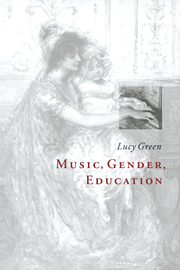Book contents
- Frontmatter
- Contents
- Acknowledgments
- 1 Introduction
- PART I MUSICAL MEANING AND WOMEN'S MUSICAL PRACTICE
- PART II GENDERED MUSICAL MEANING IN CONTEMPORARY EDUCATION
- 6 Affirming femininity in the music classroom
- 7 From affirmation to interruption of femininity in the music classroom
- 8 Threatening femininity in the music classroom
- 9 The music curriculum and the possibilities for intervention
- Bibliography
- Index
9 - The music curriculum and the possibilities for intervention
Published online by Cambridge University Press: 20 November 2009
- Frontmatter
- Contents
- Acknowledgments
- 1 Introduction
- PART I MUSICAL MEANING AND WOMEN'S MUSICAL PRACTICE
- PART II GENDERED MUSICAL MEANING IN CONTEMPORARY EDUCATION
- 6 Affirming femininity in the music classroom
- 7 From affirmation to interruption of femininity in the music classroom
- 8 Threatening femininity in the music classroom
- 9 The music curriculum and the possibilities for intervention
- Bibliography
- Index
Summary
Until recently, the field of music education has ignored gender. Countless books and articles about music education, syllabuses and curriculum materials for use in music education, have been produced as though women have played barely a part in the history of music other than as the wives, mistresses, mothers or sisters of famous male musicians; as though the musical practices of girls and boys in schools were to all intents and purposes indistinguishable; and as though any differences in the educational value and availability of music for girls and for boys were wholly inconsequential. Not only such pragmatic issues but more ephemeral questions surrounding gendered musical meanings have also been unapologetically ignored by a field which has largely understood itself to be concerned with transmitting the supposedly autonomous and universal content of musical value. These observations are by no means intended to criticise my colleagues as though I were myself wholly exonerated. My earlier book (1988) presented an analysis of the interpenetration of aesthetic ideology and musical meaning in the discourse of music education. Even though I have always considered myself a feminist, I ruled out any consideration of gender in that book because I could not at the time see how I could related it to a theory of musical meaning. Yet once one starts to enquire into some of the issues surrounding gender in music education, they become so compelling that such a refusal is no longer possible. Essentially what I have tried to do in the present book is to expand the purview of that earlier theory in order to bring it to bear upon gender.
- Type
- Chapter
- Information
- Music, Gender, Education , pp. 230 - 258Publisher: Cambridge University PressPrint publication year: 1997



